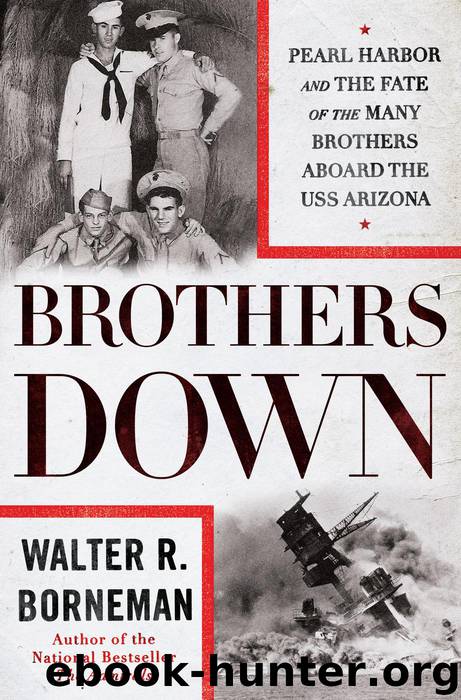Brothers Down by Walter R. Borneman

Author:Walter R. Borneman
Language: eng
Format: epub
Publisher: Little, Brown and Company
Published: 2019-05-13T16:00:00+00:00
So far, the Arizona, moored inboard from the Vestal, had been lucky, but more havoc was en route. High overhead, the increasing drone of high-altitude bombers filled the sky. Ten five-plane V formations of Kate bombers—one formation minus one plane—flew up the entrance channel toward Battleship Row and targeted the inboard battleships that had been largely protected from the torpedo attacks by their outboard neighbors. One wave of five planes released its 800-kilogram (1,760-pound) bombs against the Arizona and the adjacent Vestal.
These projectiles were sixteen-inch armor-piercing naval ordnance that had been converted to aerial bombs by adding four-inch-thick steel casing at the nose and directional fins at the tail. Teardrop shaped, they measured almost eight feet in length. The whole point of armor-piercing shells employed as bombs was that when dropped from an altitude that generated enough accelerating speed, the hardened casings penetrated armor and the impact triggered delayed fuses of several tenths of a second that then detonated the explosive component for maximum damage. When dropped from ten thousand feet from the Kates, these projectiles were capable of penetrating at least five inches of deck armor.
John Anderson and many others on the decks of the Arizona looked skyward and struggled to process why so many black objects were dropping toward them from the V-shaped formations of planes flying ten thousand feet above. Anderson started back through the hatch door, but he never reached it.
One bomb of the first salvo of five glanced off Turret No. 4 on the starboard side, likely striking the nine-inch-thick steel on the side of the turret, but it still managed to bury itself below decks and explode. Two more bombs penetrated the deck and exploded fore and aft of the base of the main mast. One, possibly two bombs, hit the Vestal. One of these detonated with a concussion that blew John Anderson inside the hatchway and, in his words, “knocked me silly.” With bullets from Japanese fighters spraying the deck around him, Anderson came to, shook himself off, and raced to his battle station in Turret No. 4. Years of training took over. He slid into his gunner’s seat and confidently announced “Manned and ready.”
That was all by the book, but the big fourteen-inch guns were meant for ship-to-ship combat and weren’t going to do any good against a swarm of planes. Anderson told his turret captain, Chief Petty Officer George Campbell, “Look, what I saw out there was a number of Japanese planes. I didn’t see any ships or anything and no shellfire. There’s all bombs and machine gun fire. We can’t do any good in here. We need some gunners on the antiaircraft batteries.” Campbell asked Anderson what he wanted to do, and Anderson replied, “I’d like to get out there and get on a gun with my brother. He’s an antiaircraft gun captain and he needs help.” Campbell thought a second and then said, “Go for it.”
But as Anderson left the turret and started up a ladder toward the antiaircraft guns on the upper decks, the entire front end of the ship erupted in a horrendous explosion.
Download
This site does not store any files on its server. We only index and link to content provided by other sites. Please contact the content providers to delete copyright contents if any and email us, we'll remove relevant links or contents immediately.
| Africa | Americas |
| Arctic & Antarctica | Asia |
| Australia & Oceania | Europe |
| Middle East | Russia |
| United States | World |
| Ancient Civilizations | Military |
| Historical Study & Educational Resources |
The Body: A Guide for Occupants by Bill Bryson(4974)
Liar's Poker by Michael Lewis(3369)
Into Thin Air by Jon Krakauer(3312)
Tuesdays With Morrie by Mitch Albom(2696)
Into the Wild by Jon Krakauer(2582)
The Diamond Cutter by Geshe Michael Roach(2019)
My Dark Places by James Ellroy(1881)
Columbine by Dave Cullen(1815)
Helter Skelter: The True Story of the Manson Murders by Vincent Bugliosi & Curt Gentry(1699)
Extraordinary, Ordinary People by Condoleezza Rice(1468)
Everything in Its Place by Oliver Sacks(1445)
Pilgrim at Tinker Creek by Annie Dillard(1390)
Into the wild by Jon Krakauer(1383)
You Can't Touch My Hair by Phoebe Robinson(1360)
The Girls: Sappho Goes to Hollywood by Diana McLellan(1281)
Dark Towers by David Enrich(1205)
Betrayal by Gregg Olsen(1203)
Call Sign Chaos by Jim Mattis & Bing West(1185)
The Letters of Allen Ginsberg by Allen Ginsberg(1113)
